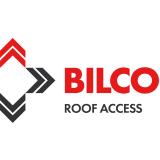This informal CPD article, ‘A comprehensive guide to roof ladder specification’, was provided by Bilco UK, leading manufacturers and suppliers of Roof Access Hatches, CE marked Natural Smoke Ventilators, Floor Doors, Fixed Vertical and Retractable Ladders. It discusses the essential factors that architects should take into account at the initial stages of a building’s design, when specifying roof ladders for upcoming projects, and provides insight into ensuring compliance with the legislation detailed in Approved Document K.
A comprehensive guide to roof ladder specification
Ladders are a crucial component when it comes to ensuring secure access to the roofs of both residential and commercial buildings. One of the primary considerations in the specification of a roof access ladder is the location of the installation, and whether there is a requirement of any additional safety features to guarantee user safety while it is in use.
If a ladder is mounted against an external wall for the purpose of gaining access to a roof, it must be fitted with a safety cage and guard rail to ensure safe access. For environments which require frequent access to the roof for maintenance personnel who will be carrying tools and equipment, architects should consider a companionway roof hatch which is elongated and best suited for purpose. Companionway ladders are 75 degree angled, rigid ladder, which provide permanent access to a roof hatch of up to 2440mm.
For smaller roof access hatches with internal dimensions of 915 x 915, rather than a retractable ladder which would hinder easy access for the individual as the user approaches the hatch, a fixed vertical ladder should instead be specified.
However, in environments which feature bigger access hatches and where the floor area must remain clear at all times, such as schools and hospitals, retractable ladders are an ideal choice. Retractable ladders can be ceiling-mounted and are compatible with vertical blackboards which feature steps and a handrail for additional user safety and have a maximum size of 1500mm.
In cases where access to the roof area through a smoke ventilator is required, a retractable ladder would not be suitable due to the construction and mechanisms causing obstruction of smoke through the smoke vent, rendering them unsafe for use. In this instance, the only recommended choice for use in conjunction with a smoke vent is a fixed vertical ladder, thanks to its smaller footprint.
When specifying a retractable ladder, accurate measures of the height between the ceiling and roof, commonly known as the roof void, are essential. This is to ensure that the ladder box liner fits inside the space when retracted. Additionally, calculating the distance between the floor and the underside of the roof access hatch during the initial planning stages is equally important in preventing the ladder from being too long or too short.
Conclusion
The specification of ladders, particularly those intended for gaining roof access, involves a range of critical considerations. To ensure compliance with relevant legislations as well as the long-term safety of users, it is essential that all factors are thoroughly addressed during the early stages of a building project. By working closely with manufacturers and adopting a proactive approach, architects can ensure that the ladders specified are not only fit for purpose long-term, but also meet the unique requirements of each development successfully.
We hope you found this article helpful. For more information from Bilco UK, please visit their CPD Member Directory page. Alternatively, you can go to the CPD Industry Hubs for more articles, courses and events relevant to your Continuing Professional Development requirements.













